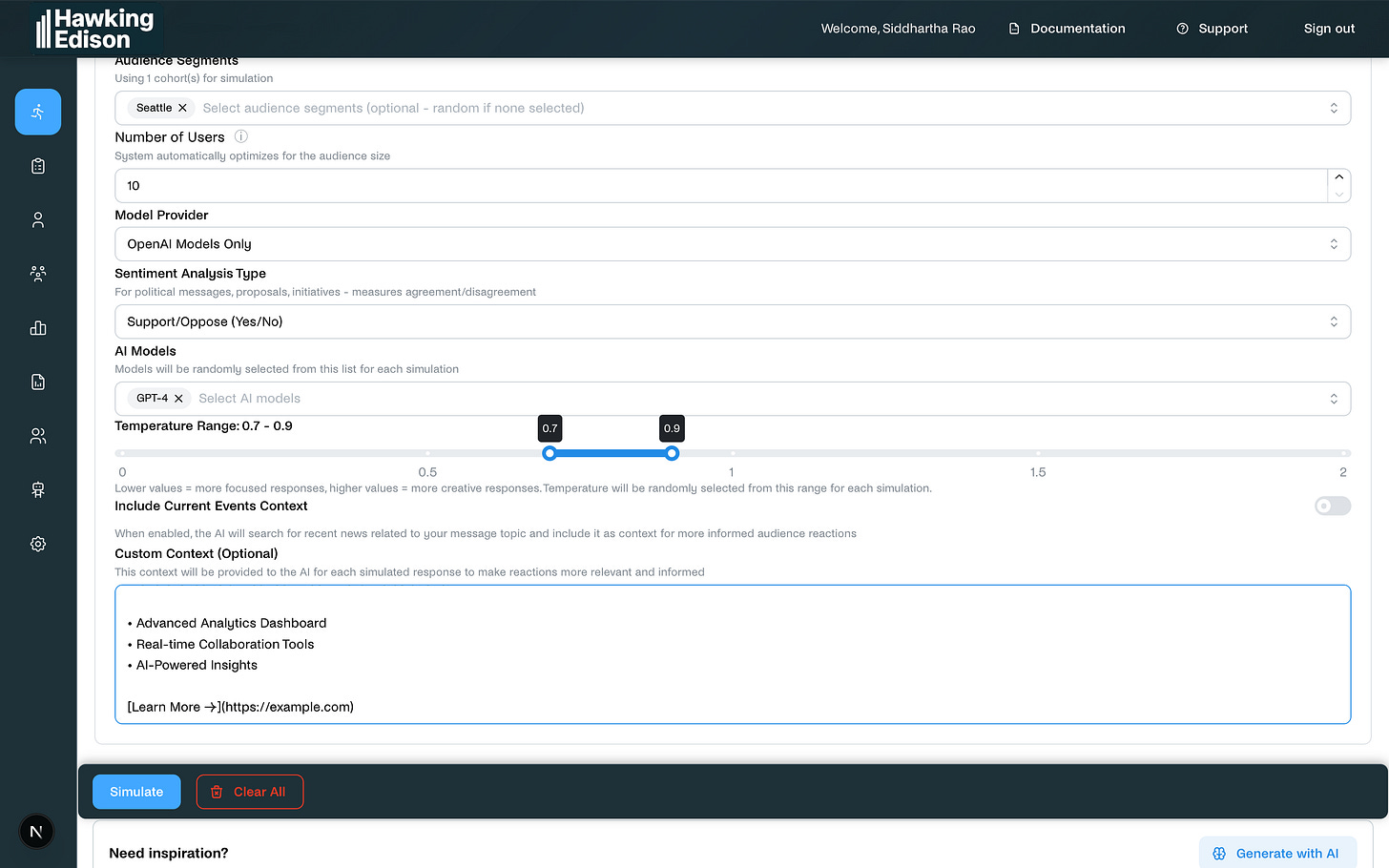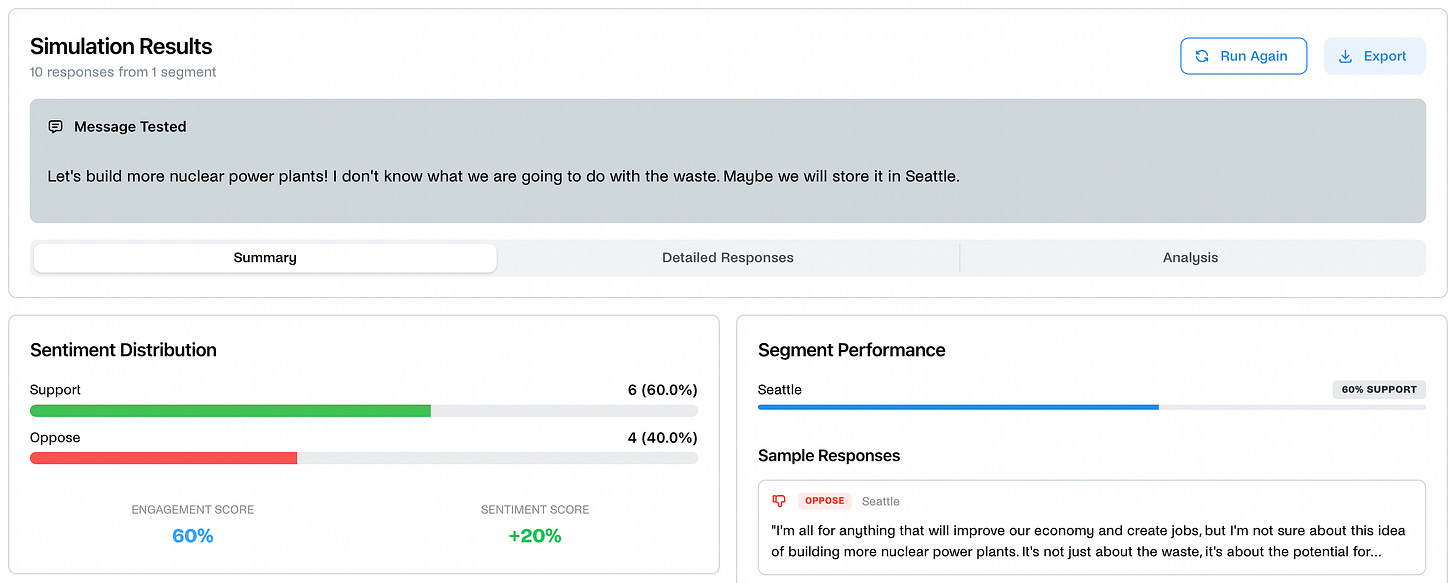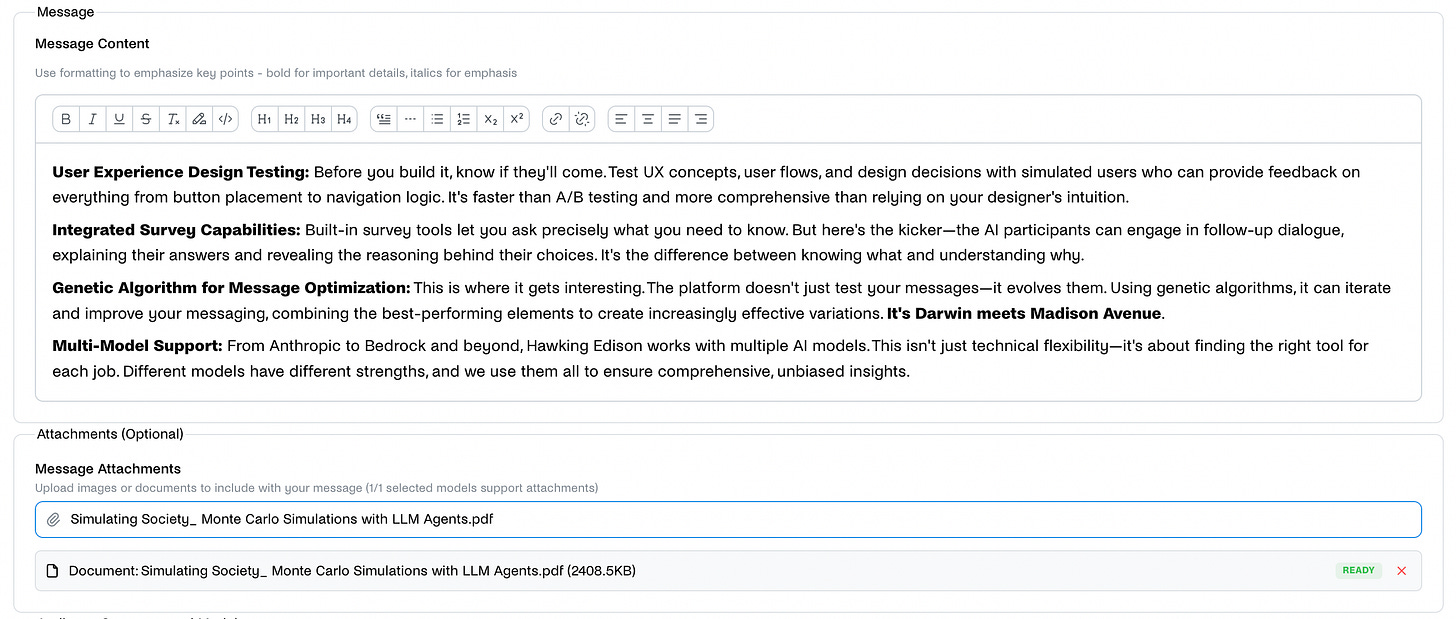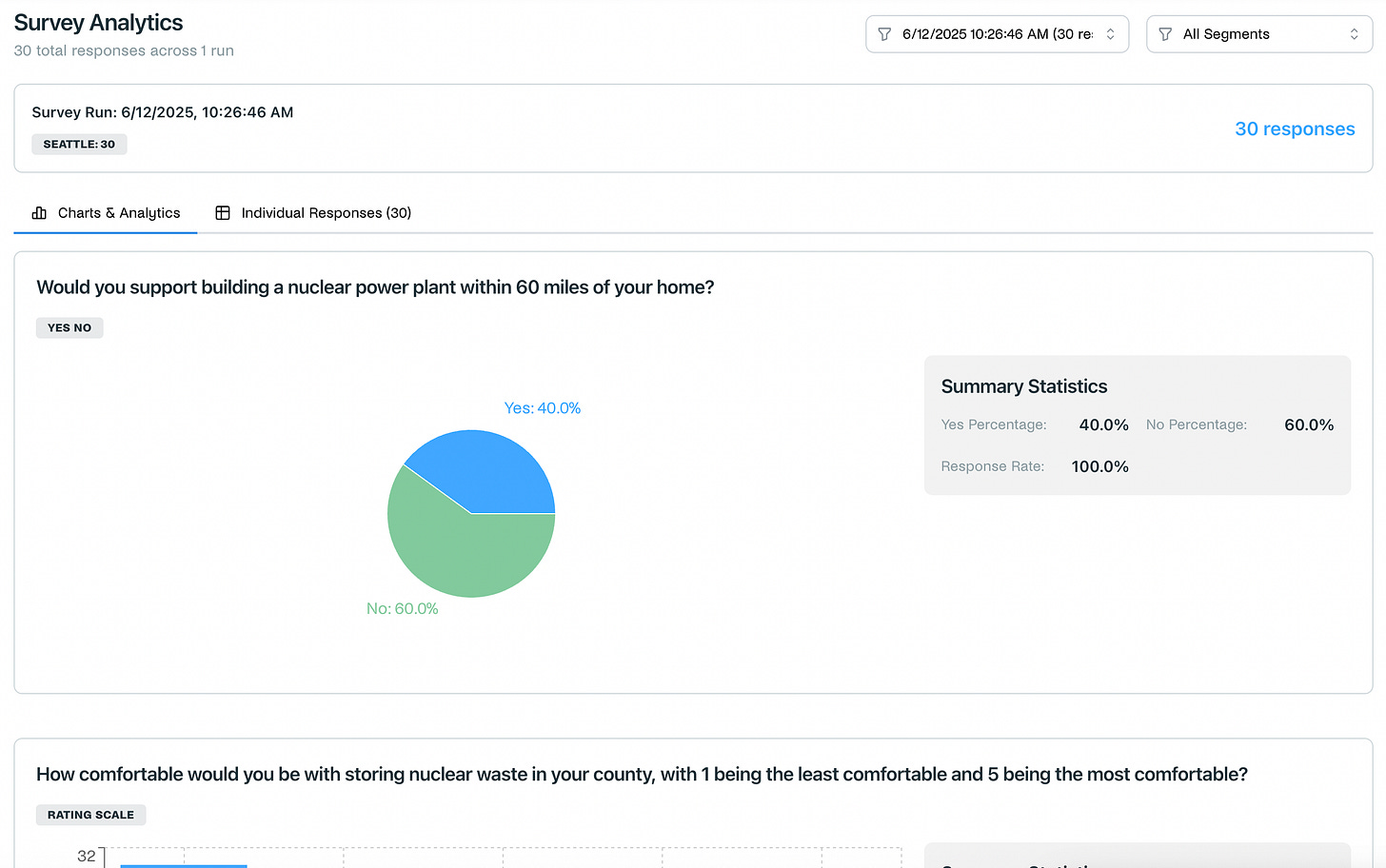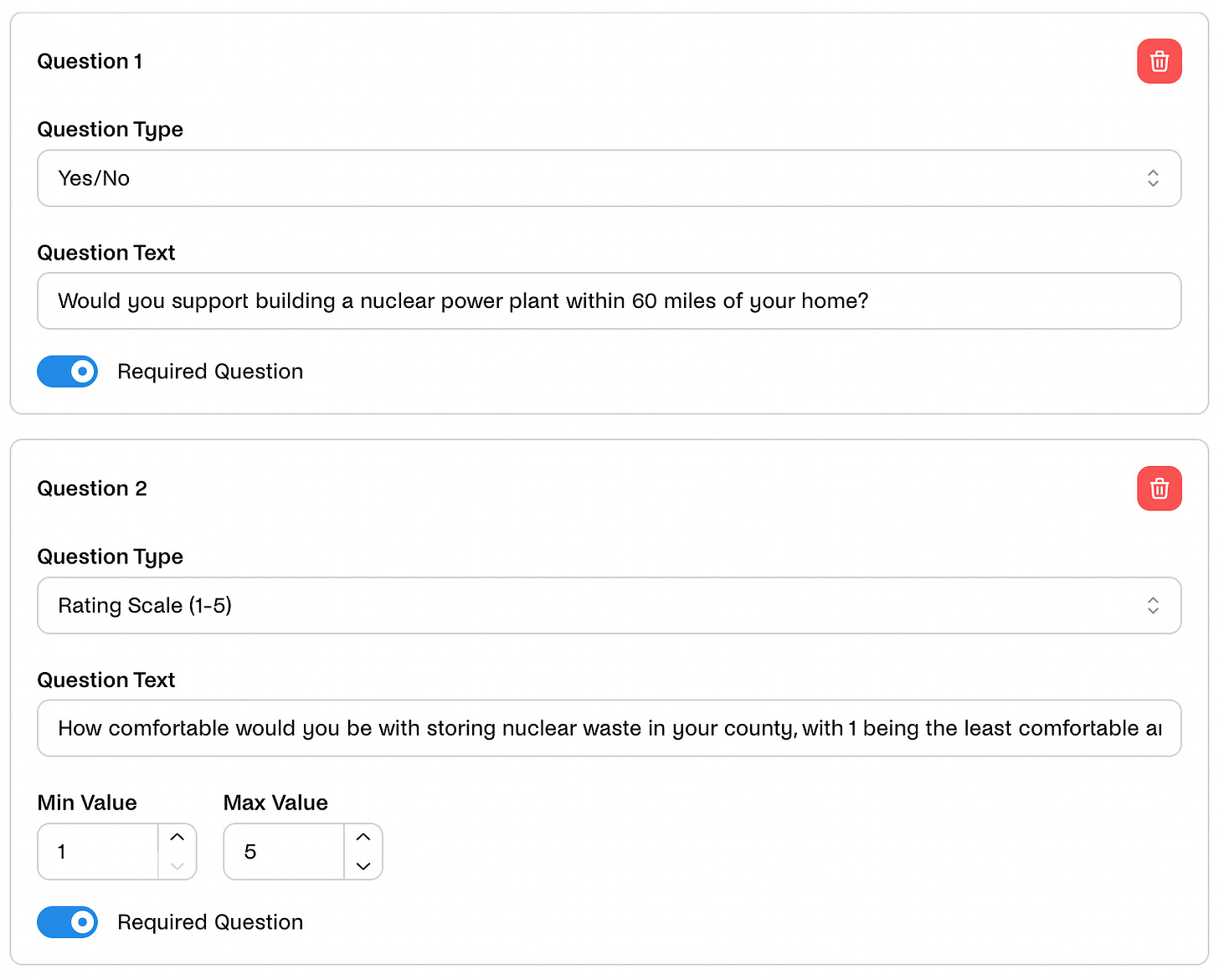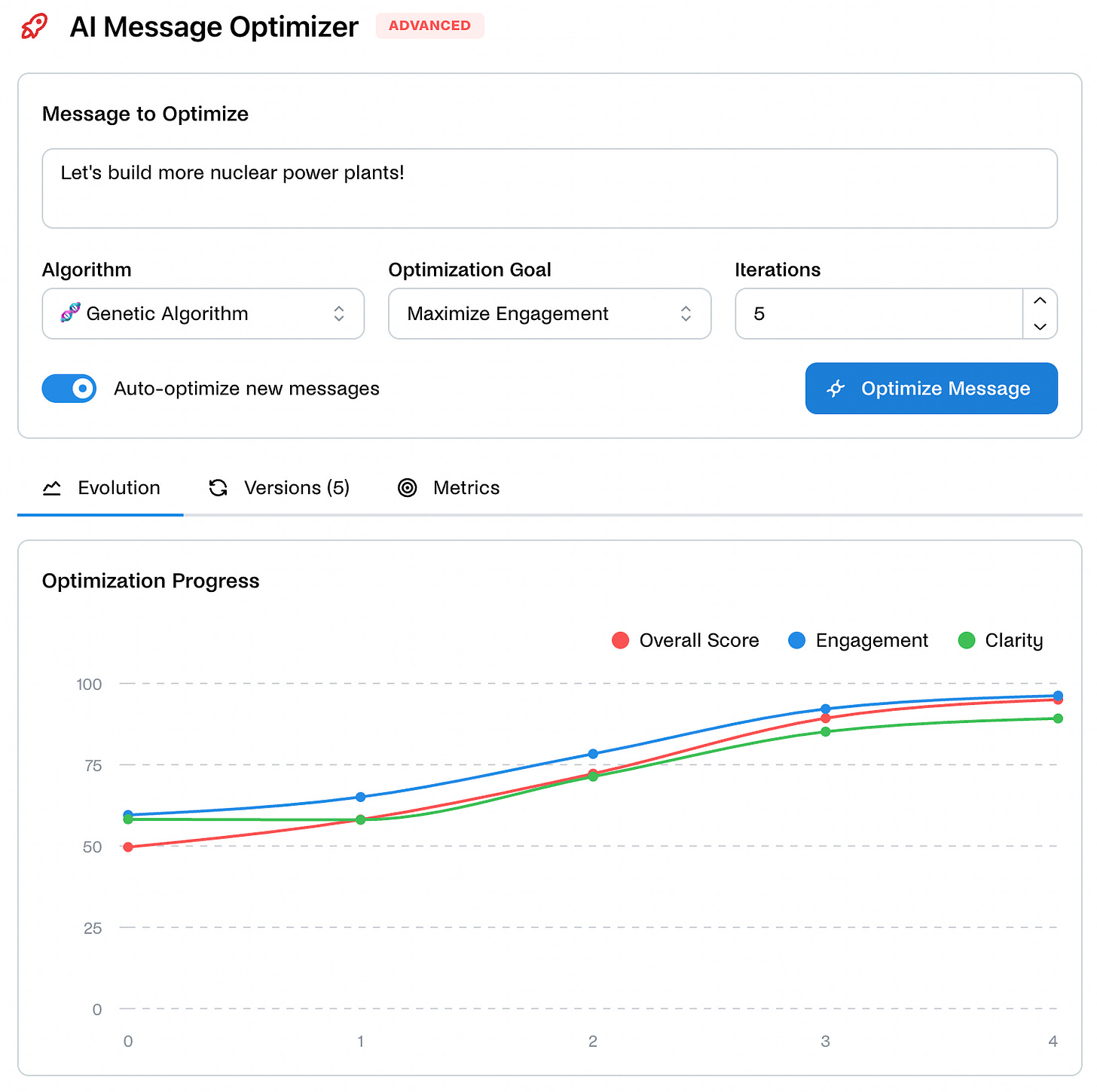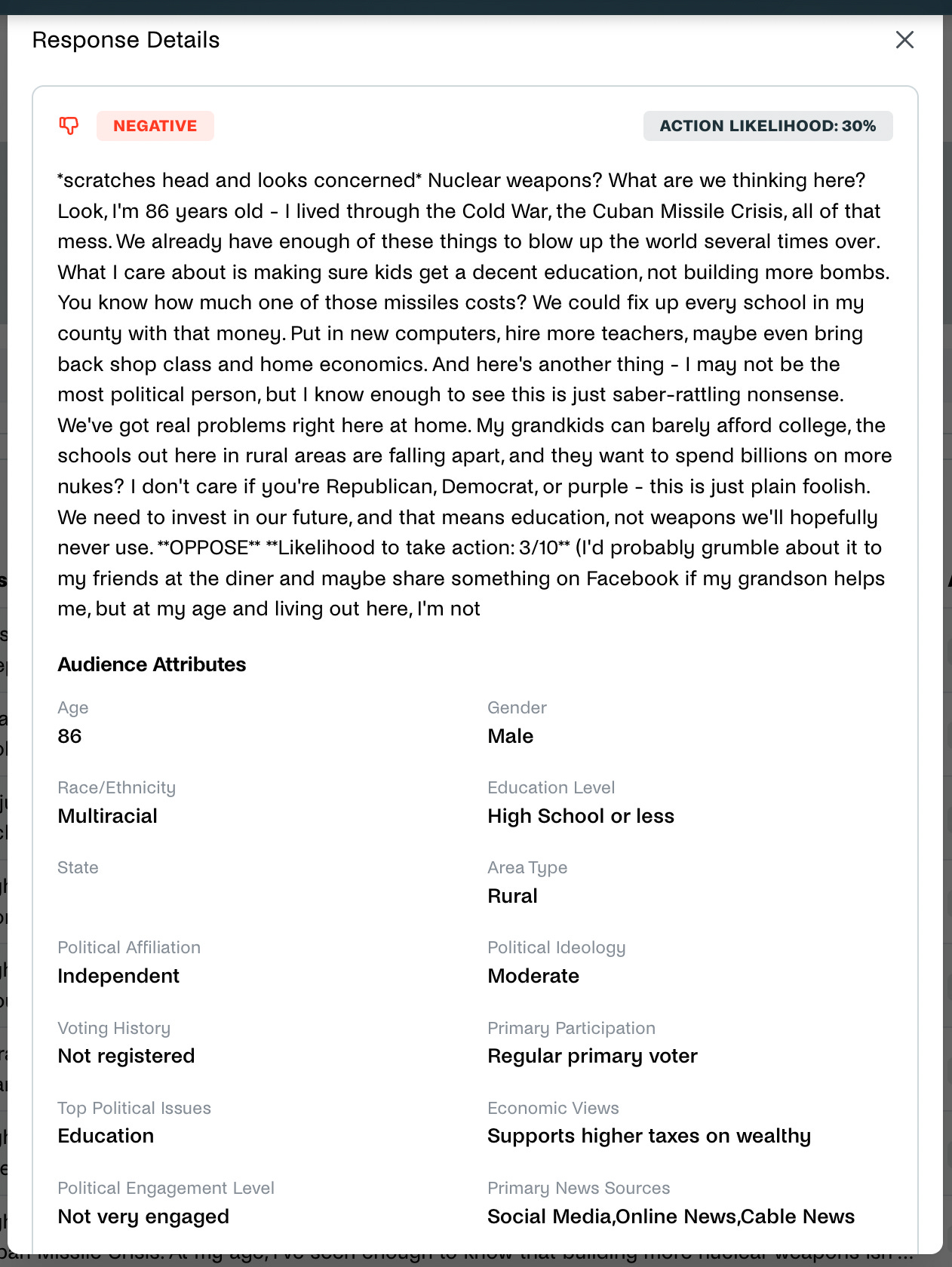Your Next Focus Group May Not Be Human: Scalable Research With Hawking Edison
Test your messaging with thousands of AI participants before spending a dollar on campaigns
Before you think I'm building Skynet, hear me out.
I've been discussing with enterprise customers the use of AI models at scale. While most focus on inbound applications, some want to run massive experiments (thousands to millions) to gain a deeper understanding of customer behavior.
They see value in testing messaging with simulated groups, similar to how Google tests the impact of ads before launching campaigns.
Here is some of my original thinking on the topic:
This inspired me to build Hawking Edison: a scalable simulation engine that validates marketing messaging, political copy, and UX designs through surveys, genetic algorithms for optimization, and support for multiple AI models.
Let me tell you something about the nature of truth in business. We spend our days making decisions based on what we think we know about our customers, but here's the thing—and this is important—most of us are operating on assumptions dressed up as insights. We're like sailors navigating by stars we painted on the ceiling.
Why your million-dollar campaign is based on a conference room guess
You know what David Ogilvy, the father of advertising, once said? "The consumer isn't a moron; she's your wife." But here's what he didn't mention—most of us have no idea what our wives actually think about our messaging. We're all just throwing words at the wall and praying something sticks.
We craft our messages in conference rooms and test them in echo chambers, then act surprised when the market responds with deafening silence.
Traditional focus groups cost more than most people's annual salaries. Think about that for a moment. The price of understanding your customer is higher than the price of employing someone for a year. That's not just inefficient—it's a moral failing of the marketplace.
The market sees this too. According to recent analysis, AI-powered market research is projected to grow at a 35.9% annual rate, reaching $467 billion by 2030. Those aren't just numbers—they're a referendum on the current state of affairs.
David just got Goliath's focus group budget
Now, I've always believed that the best ideas come from the broadest possible range of voices. The same principle applies to customer research.
When only Fortune 500 companies can afford proper market studies, we're not just limiting business success—we're limiting innovation itself.
Modern AI platforms represent something more profound than technological advancement. They represent the radical notion that every business, regardless of size, deserves to understand its customers. This isn't about replacing human insight—it's about extending the privilege of insight to those who've been priced out of the conversation.
These systems combine natural language processing, machine learning, and generative AI to create something that would have seemed like science fiction just a decade ago. They can conduct hundreds of conversations simultaneously, identify patterns humans might miss, and synthesize insights faster than you can say "statistical significance."
But it is incredibly challenging to orchestrate and manage thousands or millions of AI avatars at scale.
The economics of enlightenment
Let me paint you a picture with some numbers—and I know numbers can be tedious, but stay with me because this matters. Traditional focus groups typically cost between $6,000 and $12,000 per session. Most projects need multiple sessions. Add recruitment, facilities, and analysis, and you're looking at $50,000 to $100,000 for a single research project.
Now, AI-powered platforms? They operate at 70-90% less cost. However, what really matters is that it's not just about saving money.
It's about preventing the catastrophic cost of being wrong.
A marketing director recently told me they saved $2 million by discovering their core message was being completely misunderstood, before launch. Two million dollars. That's not cost savings; that's disaster prevention.
The coalition of the willing
What excites me most about this technology is how it empowers different voices within organizations:
Marketers can test messages with the rigor of scientists rather than the hope of gamblers. They can understand not only what resonates, but also why it resonates and with whom.
Researchers become force multipliers, able to cover more ground and ask better questions. They're not replaced—they're elevated.
Product designers can iterate based on actual user feedback rather than conjecture in conference rooms. Every feature can be tested, and every assumption can be challenged. Every string validated.
Sales teams can speak with the authentic voice of their customers, addressing objections before they're raised, using language that actually connects.
This isn't about making everyone a researcher.
It's about sparking curiosity in everyone and providing them with the tools to satisfy it.
The irreplaceable human element
Now, before anyone accuses me of techno-utopianism, let me be clear about something. Human research—real, deep, qualitative human research—remains irreplaceable.
AI gives us the map, but humans navigate the territory.
Complex emotional understanding, cultural nuance, the ability to read between the lines of what people say and divine what they mean—these remain fundamentally human skills. What AI provides is the ability to identify where we need to deploy those precious human resources.
Think of it as triage for insight. AI helps us quickly identify what needs deeper investigation, what assumptions need challenging, and where our blind spots might be hiding.
An investment in the future of understanding
Consider this: the traditional market research industry is worth $140 billion annually. Even capturing a small percentage through AI automation represents a massive opportunity.
But more than that, investing in these platforms is investing in a more informed business ecosystem. When better decisions become more affordable, everyone benefits—companies, customers, and society as a whole.
The network effects are compelling. As companies build their research history and integrate these tools into their workflows, switching costs increase. The accumulated insights become a competitive moat. It's a business model with both purpose and profit.
How Hawking Edison kills the guessing game
Here's what changes when you stop guessing and start knowing. Hawking Edison is a self-service platform—no consultants, no middlemen, no six-week turnaround times.
You log in, you ask your questions, you get answers. Today. Not next quarter.
Marketers can test thirty headlines before lunch and determine which five actually capture people's attention. They can understand why "transform your business" falls flat while "fix what's broken" gets clicks. They can segment responses by industry, company size, or job title and craft messages that address each audience's specific pain points.
Researchers get a force multiplier that would make Archimedes jealous. Run preliminary studies in hours to identify which questions deserve deeper human investigation. Test survey instruments before fielding them. Validate hypotheses before investing in full-scale research.
It's not about replacing your expertise—it's about deploying it where it matters most.
Product designers can finally escape the conference room echo chamber. Test interface concepts with hundreds of simulated users. Understand which features excite you and which confuse you. Iterate based on actual feedback patterns rather than the opinions of those who speak loudest in meetings. Every design decision can be validated before a single line of code is written.
A guided tour of Hawking Edison
Now, let me walk you through what Hawking Edison actually does—because principles without practice are just philosophy, and we're here to get things done.
Scalable Simulation Engine: At its core, Hawking Edison is a simulation engine that can run thousands to millions of simulated customer interactions. Think of it as a vast theater where every seat is filled with an AI participant trained to respond like your target customers. You're not getting five people in a room; you're getting statistical significance at a scale that would make pollsters weep with joy.
Marketing Message Testing: You write the copy, we'll tell you if it works. The platform tests your headlines, taglines, value propositions, and full campaign messages across diverse simulated audiences. It identifies which messages resonate, which fall flat, and most importantly, why. You'll know not just that "innovative solutions" make eyes glaze over, but what language actually moves your audience to action.
Political Copy Validation: Because words matter in politics as much as commerce. Test policy messages, campaign slogans, and public communications to understand how different demographics will respond. It's like having a focus group in every district, without the budget for coffee and donuts. The audience can be automatically brought up to speed on current events related to your message. Back test your message against public surveys from Pew and others to validate simulation accuracy.
User Experience Design Testing: Before you build it, know if they'll come. Test UX concepts, user flows, and design decisions with simulated users who can provide feedback on everything from button placement to navigation logic. It's faster than A/B testing and more comprehensive than relying on your designer's intuition.
Integrated Survey Capabilities: Built-in survey tools let you ask precisely what you need to know. But here's the kicker—the AI participants can engage in follow-up dialogue, explaining their answers and revealing the reasoning behind their choices. It's the difference between knowing what and understanding why.
Genetic Algorithm for Message Optimization: This is where it gets interesting. The platform doesn't just test your messages—it evolves them. Using genetic algorithms, it can iterate and improve your messaging, combining the best-performing elements to create increasingly effective variations. It's Darwin meets Madison Avenue.
Multi-Model Support: From Anthropic to Bedrock and beyond, Hawking Edison works with multiple AI models. This isn't just technical flexibility—it's about finding the right tool for each job. Different models have distinct strengths, and we utilize them all to ensure comprehensive and unbiased insights.
Real-Time Analytics Dashboard: Watch your insights emerge in real-time. The dashboard shows response patterns, sentiment analysis, demographic breakdowns, and emerging themes as they develop. No waiting weeks for a PowerPoint deck—you see what's working and what's not as it happens.
Segment Analysis: Define your customer segments, and the platform will show you how each responds differently. Whether you're segmenting by demographics, psychographics, or behavior patterns, you'll understand not just your average customer, but the full spectrum of your audience.
Export and Integration Options: Your insights shouldn't be isolated. Import the target profiles you would like to survey from Hubspot. Export your findings in multiple formats, integrate with your existing marketing and analytics tools, and build research into your standard workflow. The goal isn't to add another silo—it's to make customer understanding part of everything you do.
I plan on adding direct CRM integrations, support for avatars to access MCP resources, and social media integrations.
The beauty of Hawking Edison is that all these features work together. Test a message, see how it performs, let the genetic algorithm improve it, test again, analyze by segment, refine your approach, and launch with confidence. It's not just research—it's a continuous cycle of understanding and improvement.
And here's what matters most: You don't need a research degree to use it. The platform guides you through the process, suggests best practices, and helps you interpret results.
We've democratized not just the tools, but the expertise to use them effectively.
The compound effect of continuous insight
When insights become affordable and immediate, something fundamental shifts in how organizations operate.
Decisions are based on validated learning rather than accumulated assumptions.
With Hawking Edison, you're not running one focus group per quarter and hoping it represents everyone. You're testing continuously, learning constantly, and adapting in real-time.
A marketing team can test regional variations of a campaign and launch with messages tailored to each market.
A product team can validate every sprint's output with user feedback.
A sales team can refine its pitch based on actual objection patterns, not theoretical ones.
The platform learns with you. Every test adds to your understanding. Every insight builds on the last. After six months, you're not just guessing better—you're operating from a foundation of validated customer knowledge that your competitors are still trying to buy for six figures.
This isn't an incremental improvement. It's the difference between navigating by stars and navigating by GPS. And in a world where customer preferences shift faster than ever, that difference determines who thrives and who gets left behind, wondering why their perfect campaign perfectly missed the mark.
The conversation continues
This revolution in customer understanding is just beginning, and like all revolutions, it will be shaped by those who participate in it.
If you're using these tools, struggling with these challenges, or considering these possibilities, I'd like to hear from you.
Direct message me with your thoughts, successes, failures, and dreams for what customer research could become.
Ultimately, that's what this is really about. Not the technology, not the cost savings, not even the competitive advantage. It's about the radical act of listening at scale. It's about building businesses that serve real needs rather than imagined ones. It's about replacing guesswork with understanding.
The gap between customer questions and actionable insights has never been smaller. The only question that remains is this: What truth about your customers are you brave enough to discover?
Contact me today to collaborate and learn more!
P.S. Hawking Edison is named after my two dogs - it’s their middle names joined together. Renaming it might be tough (my wife loves the name), but I’m open to ideas. I have always struggled with naming my projects. Help me out!



